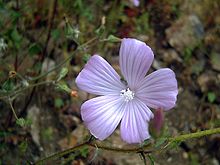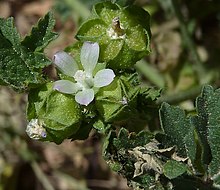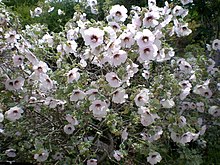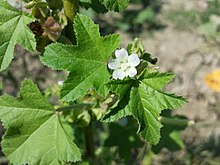Mallow
| Mallow | ||||||||||||
|---|---|---|---|---|---|---|---|---|---|---|---|---|

Wild mallow ( Malva sylvestris ) |
||||||||||||
| Systematics | ||||||||||||
|
||||||||||||
| Scientific name | ||||||||||||
| Malva | ||||||||||||
| L. |
The mallow ( Malva ) are a genus of flowering plants in the family of mallow (Malvaceae). The 15 to 30 species are common in Eurasia and North Africa.
Naming
The word "mallow" goes back to a Mediterranean language via Latin malva (especially wild mallow or path mallow , possibly also rose mallow and common hollyhock , but also true marshmallow ) and ancient Greek μαλάχη maláche (cf. Arabic Muluchiya and Hebrew mallūah for the unrelated garden report ).
description



Appearance and leaves
Mallow species grow as ascending or upright, annual to perennial or short-lived herbaceous plants . The alternate arranged on the stems leaves are stalked. The leaf blades are palmately lobed or occasionally deeply incised. The remaining stipules are sessile and mostly ciliate.
blossoms
The flowers are either singly or in clusters in the leaf axils. The three mostly ungrown bracts of the shell, which are also often interpreted as outer calyx, vary in shape from linear to ovoid.
The hermaphrodite flowers are radially symmetrical and five-fold. The five sepals are fused, cup-shaped, often enlarging until the fruit is ripe and then protruding from the axis. The five petals are mostly purple, occasionally white, pink or red. They are notched or indented at their tip.
As with all representatives of the subfamily Malvoideae , the many stamens with their stamens have grown together to form a tube surrounding the pistil , the so-called columna , at the tip of which the anthers arise. The dust bags are only equipped with one theca . The upper ovary has nine to fifteen compartments. Each compartment contains an ovule . The stylus is branched into as many branches, such as the ovary has compartments. The scars are directed towards the center of the flower.
In 1915 Richard Willstätter isolated the anthocyanin dye malvidin as the dimethyl ether of delphinidin for the first time from the violet-flowered wild mallow ( Malva sylvestris ) .
Fruits and seeds
The split fruit flattened at the pollen consists of nine to fifteen sub-fruits and does not open. The partial fruits have angular side edges, but no thorns. Each partial fruit houses a seed that adheres to the walls of the partial fruit.
Locations
Many species thrive in disturbed locations.

Systematics and distribution
The genus Malva was established in 1753 by Carl von Linné in Species Plantarum . As lectotype was Britton and Brown 1913 Malva sylvestris L. fixed. Synonyms for Malva L. are: Axolopha (DC.) Alef. , Stegia DC. , Dinacrusa G. Cancer .
The genus Malva belongs to the tribe Malveae in the subfamily Malvoideae within the family Malvaceae . The genus Malva is part of a complex of several closely related genera ( Malva , Lavatera , Malope , Kitaibelia , Alcea and Althaea ), which are difficult to distinguish from one another. Molecular genetic studies showed that the genera are paraphyletic to one another . So far it is unclear what a new division of the complex could look like; a division into two ( Malva and Malope ) or one into four or more genera would be considered. The number of species can therefore just as little as the traditional division of the genus into sections. However, there is a tendency towards a broader genus Malva .
The traditionally sized Palaeoarctic genus Malva is common in Eurasia and North Africa; some species previously assigned to Lavatera and now to Malva are native to North America and Australia.
There are 15 to 30 types of Malva :
- Malva acerifolia (Cav.) Aleph. (Syn. Malva canariensis M.F. Ray , Lavatera acerifolia Cav. ): It occurs only in the Canary Islands .
- Malva aegyptia L .: It occurs in southern Europe , North Africa and the Middle East .
- Rose Mallow ( Malva alcea L. )
- Tree-shaped poplar ( Malva arborea (L.) Webb & Berthel .; Syn .: Lavatera arborea L. , Malva eriocalyx (Steudel) Molero & JMMonts. , Malva dendromorpha M.F.Ray )
- Malva assurgentiflora (Kellogg) MFRay (Syn. Lavatera assurgentiflora Kellogg ): It occurs only in California .
- Malva cathayensis M.G. Gilbert, Y.Tang & Dorr : It is native to India .
- Malva cretica Cav. : It occurs in southern Europe, North Africa and the Middle East.
-
Malva davaei (Cout.) Valdés : With two subspecies:
- Malva davaei subsp. davaei : It occurs in Spain and Portugal.
- Malva davaei subsp. mauritanica (Durieu) Valdés (Syn .: Lavatera mauritanica Durieu ): It occurs in Morocco, Algeria, Portugal, Spain and Tenerife.
- Malva hispanica L .: It occurs in Morocco, Algeria, Portugal and Spain.
- Malva iljinii Riedl
- Malva lindsayi (Moran) MFRay (Syn .: Lavatera lindsayi Moran ): It was described from California.
- Malva microphylla (Baker f.) Molero & JM Monts. (Syn .: Lavatera microphylla Baker f. , Malva bakeri Molero & JMMonts. Nom. Illeg.): The home is Morocco .
- Musk mallow ( Malva moschata L. )
- Malva multiflora (Cav.) Soldano, Banfi & Galasso (Syn .: Lavatera cretica L. , Malva pseudolavatera Webb & Berthel. , Malva linnaei M.F.Ray ): It occurs in southern Europe, in North Africa, on Cape Verde , on Madeira and on the Canary Islands , Cyprus , the Sinai Peninsula and Western Asia .
- Way mallow ( Malva neglecta Wallr. )
- Nice cheese poplar ( Malva nicaeensis All. ): It occurs in southern Europe, in North Africa, on the Canaries and Madeira, on the Arabian Peninsula , in West Asia, on Cyprus, on the Sinai Peninsula, in the Caucasus and in Central Asia .
- Malva occidentalis (S.Watson) MFRay (Syn .: Lavatera occidentalis S.Watson ): It occurs only in Baja California .
- Malva pacifica M.F.Ray (Syn .: Lavatera venosa S.Watson ): It occurs only in Baja California .
- Malva parviflora L .: It occurs in southern Europe, in North Africa, in West Asia, on the Arabian Peninsula, in the Caucasus and in Turkmenistan .
- Malva preissiana Miq. (Syn .: Malva australiana M.F. Ray , Lavatera plebeia Sims ): It occurs in Australia .
- Small-flowered mallow ( Malva pusilla Sm. , Syn .: Malva borealis Wallman ): It is widespread in Eurasia from Turkey to eastern Siberia , Kazakhstan , Kyrgyzstan , Turkmenistan , Uzbekistan , Tibet , China and Mongolia .
- Malva stipulacea Cav. : It was described from Spain.
- Beach poplar ( Malva subovata (A.DC.) Molero & JMMonts. , Syn .: Lavatera maritima Gouan , Malva wigandii (Alef.) MFRay )
- Wild mallow ( Malva sylvestris L .; Syn .: Malva erecta C. Presl ): It is used as a vegetable and medicinal plant. Contains malvidin .
- Malva thuringiaca (L.) Vis. (Syn .: Lavatera thuringiaca L. )
- Malva tournefortiana L .: It occurs in Portugal , Spain , France , Montenegro and Morocco.
- Cup mallow ( Malva trimestris (L.) Salisb. , Syn .: Lavatera trimestris L. )
-
Whorled mallow ( Malva verticillata L. ): There are at least three varieties:
- Malva verticillata var. Crispa L .: It is cultivated and is wild in many areas of the world.
- Malva verticillata var. Rafiqii Abedin : It occurs in China, Korea , northern India and Pakistan .
- Malva verticillata L. var. Verticillata (Syn .: Malva chinensis Mill. , Non Malva sinensis Cav. , Malva mohileviensis Downar , Malva pulchella Bernhardi , Malva verticillata subsp. Chinensis (Mill.) Tzvelev , Malva verticillata var. Chinensis (Mill.) SYHu ): It is widespread in China, India, Korea, Myanmar, Ethiopia as well as Europe and perhaps in Bhutan.
- Malva vidalii (Pau) Molero & JMMonts. (Syn .: Lavatera vidalii Pau ): The homeland is Morocco.
use
Because of their aroma, some types of mallow are mainly used in the industry for cosmetics or as mallow tea. Tea made from the leaves of the wild mallow is also a remedy for dry coughs. The varieties of some mallow species are used as ornamental plants.
swell
- Ya Tang, Michael G. Gilbert, Laurence J. Dorr: Malva . In Wu Zheng-yi, Peter H. Raven, Deyuan Hong (Eds.): Flora of China . Volume 12: Hippocastanaceae through Theaceae . Science Press / Missouri Botanical Garden Press, Beijing / St. Louis 2007, ISBN 978-1-930723-64-1 , pp. 265 (English). , PDF file , online. (Sections Description, Occurrence and Systematics)
- Stewart Robert Hinsley: Malva in the Malvaceae website. (Sections Description, Occurrence and Systematics)
Individual evidence
- ↑ Gottfried Muys: Research in the field of ancient peoples and the history of myths. 1st part: Greece and the Orient. JM Heberle , Cologne, 1856. p. 107 ( online in the Google book search)
- ↑ a b c d e f g h i Ya Tang, Michael G. Gilbert, Laurence J. Dorr: Malva . In Wu Zheng-yi, Peter H. Raven, Deyuan Hong (Eds.): Flora of China . Volume 12: Hippocastanaceae through Theaceae . Science Press / Missouri Botanical Garden Press, Beijing / St. Louis 2007, ISBN 978-1-930723-64-1 , pp. 265 (English). , PDF file , online.
- ↑ Sultanul Abedin: Malva . In: Eugene Nasir, SI Ali (ed.), Sultanul Abedin: Flora of West Pakistan 130. Malvaceae. Stewart Herbarium, Rawalpindi, 1979, p. 34 (online).
- ↑ Richard Willstätter, Walter Mieg: Investigations on the anthocyanins. VIII. About the dye of the wild mallow. In: Justus Liebig's Annals of Chemistry. Volume 408, No. 1, 1915, pp. 122-135, DOI: 10.1002 / jlac.19154080108 .
- ↑ Carl von Linné: Species Plantarum. Volume 2, Lars Salvius, Stockholm 1753, p. 687, digitized
- ↑ Malva at Tropicos.org. Missouri Botanical Garden, St. Louis
- ↑ a b c d e f g h i j Malva in the Germplasm Resources Information Network (GRIN), USDA , ARS , National Genetic Resources Program. National Germplasm Resources Laboratory, Beltsville, Maryland.
- ^ Stewart Robert Hinsley: The Malva Alliance on the Malvaceae website .
- ↑ a b c d e f g h i Benito Valdés: Malvaceae : Malva In: Euro + Med Plantbase - the information resource for Euro-Mediterranean plant diversity. Berlin 2011.
- ↑ a b c d e f Martin Forbes Ray: New combinations in Malva (Malvaceae: Malveae). In: Novon. Volume 8, No. 3, 1998, pp. 288-295, online.
- ^ F. Conti et al .: Integrazioni alla Checklist della flora vascolare italiana. In: Natura Vicentina. Volume 10, 2007, pp. 5-69, PDF file.
- ↑ a b Julián Molero Briones, Josep María Montserrat Martí: Nomenclatura de algunas especies del género Malva Linnaeus (Malvaceae). In: Fontqueria. Volume 55, No. 38, 2006, pp. 285-292, PDF file.
- ↑ Ursel Bühring: Practical textbook Medicinal Herbal Science: Basics - Application - Therapy , Thieme Verlag






